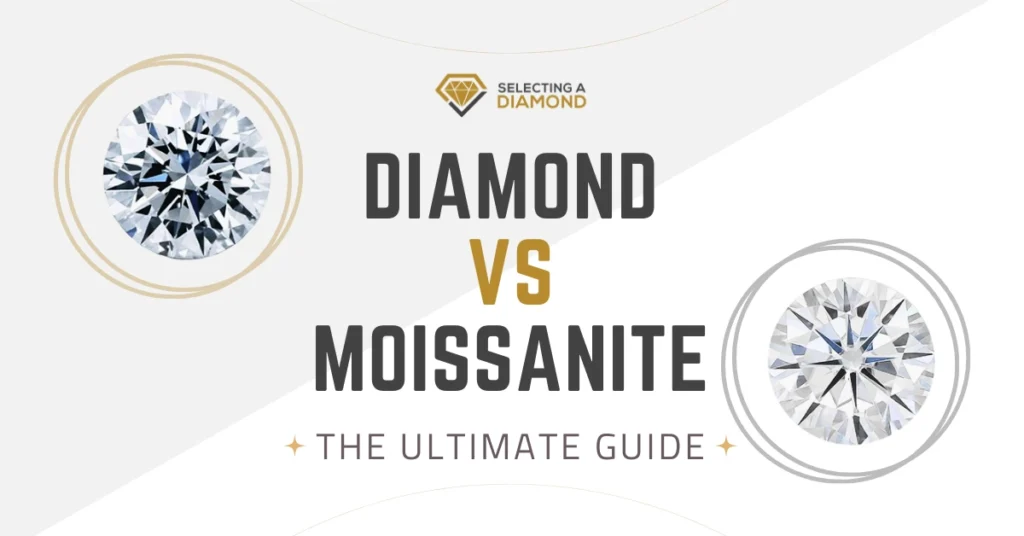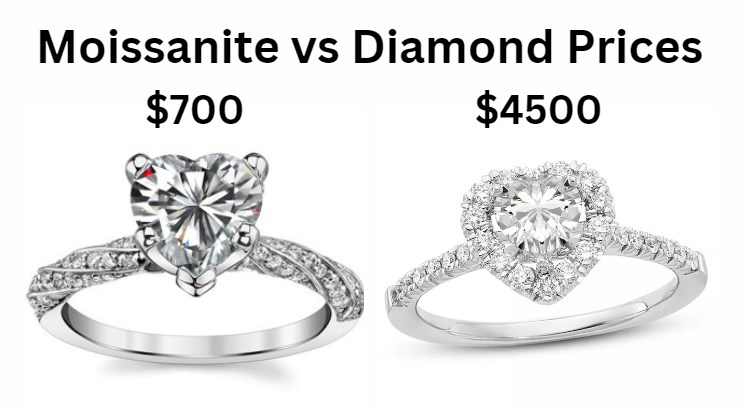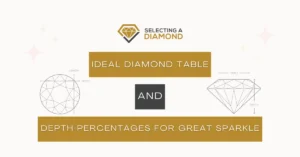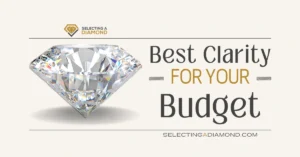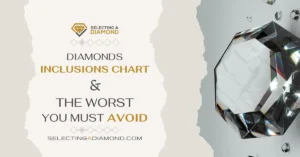We may earn a commission when you purchase through our affiliate links, at no extra cost to you. This helps support our work and allows us to continue providing unbiased, expert diamond advice.
Gemstones have been cherished and recognized as symbols of love, luxury, and undying elegance. It is no question that diamonds, out of all gemstones, are the most sought-after type of gem. However, a dazzling competitor has emerged in recent years: moissanite.
You may be thinking to yourself “No way. Diamonds are so much better than moissanite!” But we have some secrets to unlock on both stones, so keep reading about diamond vs moissanite and what makes moissanite up for the battle.
Are Moissanite Diamonds?
Moissanite, a diamond simulant, is made of silicon carbide and is one of the hardest stones naturally grown on Earth.
Moissanite diamonds were discovered in the 19th century, and moissanite is a lab-grown gemstone with excellent qualities that are similar to diamonds and in some ways even better than diamonds.
Moissanite diamonds aren’t real diamonds due to the significant differences between diamonds and moissanite. However, if you’re looking for an engagement ring and feel lost between the various options in the market, check out Blue Nile and use the diamond finder tool or stick along as we discuss diamond vs moissanite and all of their similarities and differences.
A Brief on Diamond
Diamond is made of carbon and it is the world’s hardest gemstone found in nature. Diamonds are cherished and adored for their hardness, clarity, and rich value, as they’re completely made from a single element.
Diamonds are available in two forms or types; natural diamonds or lab-grown diamonds. Natural diamond rings are as authentic as lab-grown diamond rings, and both options are available for buyers all over the world.
Diamond vs Moissanite
The debate of diamond vs moissanite has sparked conversations among jewelry enthusiasts, each praising the unique qualities of these gemstones when buying the best diamonds out there.
The pros and cons of diamond vs moissanite go down to 6 main aspects of comparison: formation, durability, clarity, color, brilliance, and price.
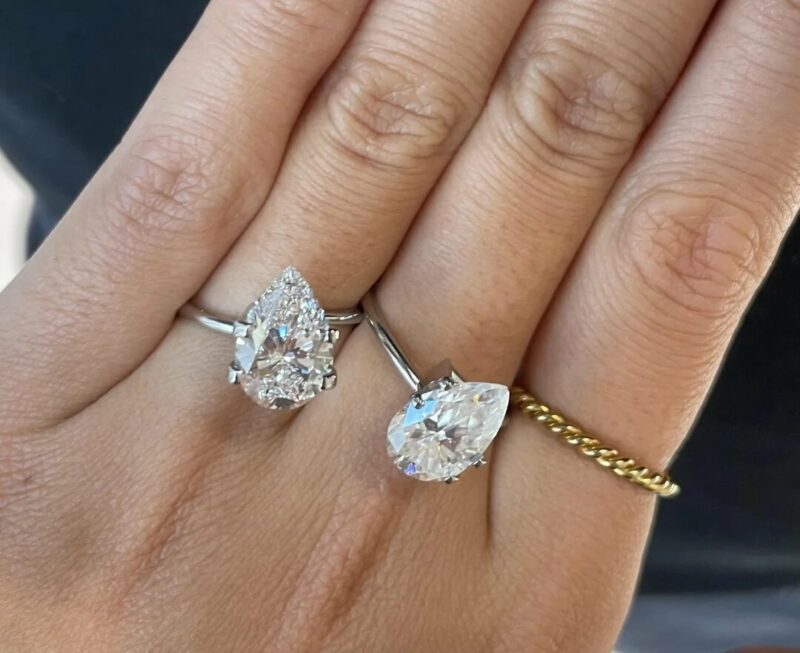
Each one of the mentioned aspects reveals either an advantage or disadvantage in the difference between moissanite and diamond, offering you a uniquely comprehensive perspective on each one, hence, helping you choose from the stunning Blue Nile engagement rings for you or your partner.
Formation
Diamond is made from one element which is carbon, unlike moissanite which is made from silicon carbide (a mixture of silicon and carbon).
This distinction in the elements of diamond vs moissanite makes the whole difference between them on all levels: social perception, price and value, and appearance.
Durability
Durability refers to toughness and hardness which reflects the stone’s ability to resist wear, high temperatures, and chemical substances.
When measuring the durability of a moissanite ring vs diamond experts found that diamond has a hardness of 10 whereas moissanite has a hardness of 9.25-9.5 making it the second of the world’s hardest gems.
This means that there’s no significant difference between diamond vs moissanite on the Moh Scale of Hardness as both of them are highly durable and have what it takes to resist tough conditions when worn daily or even occasionally, such as wearing James Allen diamonds for unmatched beauty.
If you’re searching for an alternative to diamonds, then buying a moissanite ring is your best option as it’s very tough against scratches with everyday use.
Clarity
When it comes to the clarity of diamond vs moissanite and which is clearer, experts found that moissanite has better clarity than diamonds.
This can be seen in the small imperfections or inclusions that appear under the examination of moissanite vs lab diamond and natural diamond where moissanite wins for having minimal imperfections.
It is worth noting that the clarity level in any type of diamond or gemstone affects its value. For instance, when comparing the price of lab grown diamond vs moissanite we find that their clarity level affects the price and value of both gems, so be careful when selecting engagement rings for their clarity scale, and we encourage you to check out James Allen diamond rings as they offer different clarity levels.
Also, it is noted by experts that lab-grown diamonds are clearer than natural diamonds, making them a top choice for many buyers seeking a very clear diamond stone.
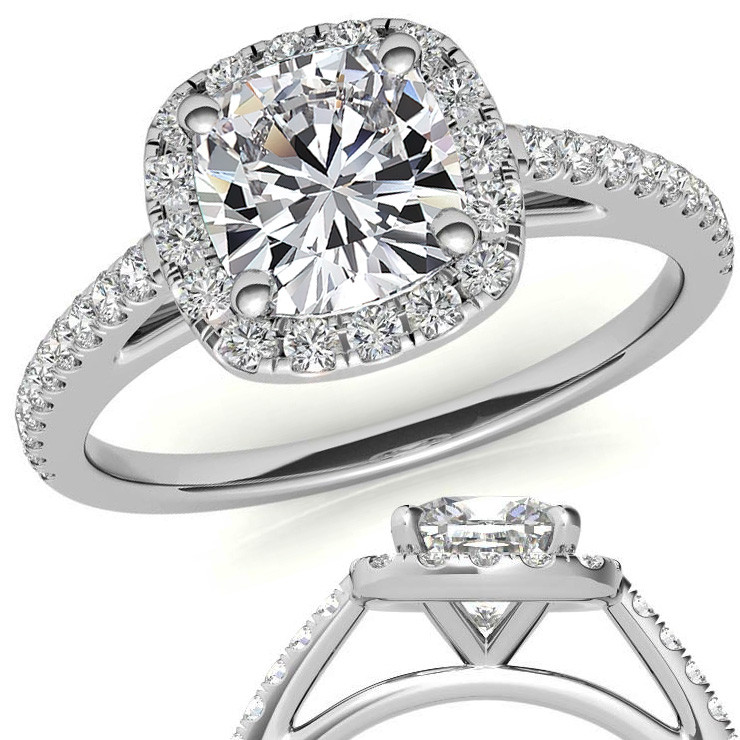
Color
Within a gemstone, color represents the natural pigment or absence thereof that is perceptible.
The human eye can’t always notice the difference in the color of diamond vs moissanite but labs can.
Moissanite has a light yellowish color that is hard to notice when the stone is small to medium in size.
However, the bigger the moissanite stone, the more noticeable the yellowish color it reflects, so always keep the size of the stone in mind when opting for a new moissanite ring for your engagement.
A diamond, on the other hand, could be colorless or yellowish, depending on the diamond’s color grade. For example, diamonds with lower grades (I, J, K and lower) can resemble a yellowish color.
Nevertheless, many diamonds are famous for their pure white appearance, which enables diamond rings to take the color of the skin naturally without any coloring in reflections.
Discovering James Allen vs Blue Nile diamond rings options save you time and effort when choosing fancy colored diamond rings like purple, yellow, and pink. Although colorless diamonds are classic, Blue Nile colored diamonds are rapidly trending.
Brilliance
Describing brilliance in diamond vs moissanite involves capturing the way light reflects from within the gem, creating a radiant effect.
Moissanite is the most brilliant gem in the world, and diamonds come second among the shiniest stones for engagement rings worldwide.
Moissanites reflect rainbow colors while diamonds reflect a pure white color and this difference between moissanite and diamond is the most prominent one of all the comparison aspects.
Love the reflection of rainbow colors on a moissanite diamond ring? We urge you to pick a moissanite ring with a rainbow reflection as it is more brilliant than diamonds when comparing moissanite rings vs diamond under sunlight.
While some individuals adore the vibrant, multicolored bursts produced by moissanite diamonds, others express concerns that the heightened brilliance of moissanite may result in a “disco-ball” appearance, particularly when exposed to sunlight.
Ladies and gentlemen who prefer to purchase a shiny diamond with a pure white color should check out these brilliant Blue Nile engagement rings.
Price
Diamonds are far more expensive than moissanite when comparing moissanite vs diamond price in all online diamond stores like James Allen and Blue Nile.
Several factors affect the moissanite diamond price; the most important is size. Opting for a two carat diamond will cost you $12k+, while a two carat moissanite can be found around $1.2k-$1.5k.
When checking the price of moissanite vs diamond (lab-grown or natural) you will find various options, and we can help you understand more about the price of natural and lab grown diamonds to make better choices according to your budget.
Natural and Lab-Grown Diamonds Prices
Discussing natural & lab-created diamond price, it is important to consider that the costs of natural diamonds and lab-created diamonds can differ depending on factors such as diamond shape, carat weight, cut, color, and clarity, even though lab-grown diamonds and natural diamonds are both real, but they have huge price difference.
Generally speaking, natural diamonds are more expensive than lab-grown diamonds by James Allen which are famous for their white brilliance.
One significant advantage of lab-grown diamonds is their comparatively lower price point. They are typically priced lower than natural diamonds of similar size and quality. This affordability allows buyers to enjoy a larger or higher-quality diamond within their budget when choosing between a lab-grown or natural diamond like Blue Nile natural diamond rings.
In general, we’re talking about 30-40% cheaper prices for lab grown diamonds compared to natural diamonds.
When considering lab grown diamond vs natural ones and specifically their price difference, you should know your preferences and set a budget that matches them.
Moissanite Prices
To fully comprehend the moissanite vs lab diamond comparison or even natural diamonds, you should know that moissanite diamonds are known for their affordability compared to both natural and lab-created diamonds.
The affordability of moissanite allows individuals to choose bigger stones or opt for higher-quality options within their budget. This flexibility makes moissanite an appealing choice for engagement rings, wedding bands, and other jewelry pieces, offering a glamorous and budget-friendly alternative to natural diamonds.
The average price of a 1 carat moissanite ring is $600-$800, whereas the average price of a 1 carat diamond is at least $4.5k.
As shown, moissanite costs can be hugely lower than diamonds.
If you’re looking for engagement rings under 5,000 dollars then Blue Nile is your go-to, but if you have a higher budget then here are some James Allen diamond rings above 5,000 dollars from all shapes.
Where to Buy Moissanite?
If you opted in to get a moissanite, we recommend these online stores:
1. Brilliant Earth
Known for their commitment to ethical sourcing and environmentally conscious practices, Brilliant Earth offers a wide selection of fine jewelry featuring premium quality moissanite gemstones. They offer moissanite stones in various cuts, colors, and sizes, set in a range of metal options. Their user-friendly website makes it easy to customize your jewelry.
2. Charles & Colvard
As the original creators of gem-grade moissanite, Charles & Colvard offer a vast selection of moissanite jewelry. They offer a lifetime warranty on their stones, a testament to their confidence in moissanite’s durability. They have patented their cutting process, which allows their moissanite to display exceptional brilliance and fire.
3. MoissaniteCo
A popular online retailer of moissanite jewelry, MoissaniteCo offers a wide range of options from engagement rings to earrings, necklaces, and bracelets. Their jewelry is customizable by stone size, shape, and type of metal. They pride themselves on their customer service and offer a range of educational resources to help shoppers understand moissanite’s unique properties.
FAQs
What is moissanite diamond?
Moissanites are not real diamonds as they are significantly different from diamonds, but they’re a simulant of them. However, they’re naturally grown stone that is processed in labs under extreme heat and pressure to be shaped into gems and sold in markets.
Why are diamonds more expensive than moissanite?
Diamonds are more expensive than moissanite because of their rarity, limitations of supply and demand, production and mining costs, and social and market perception. This difference also applies with lab grown diamond vs moissanite in shops like Blue Nile and James Allen.
Whether you choose the delightful allure of diamonds or the radiant brilliance of moissanite, both gemstones possess their distinct charisma which we showcased in our diamond vs moissanite comparison. The world of fine jewelry continuously develops and embraces alternatives that cater to diverse tastes and values and Selecting A Diamond always keeps you updated.
Diamonds vs Moissanite: Summary
Diamonds and moissanite, a diamond simulant, are both popular gemstones, with the former prized for its hardness and clarity, and the latter for its affordability and close resemblance to diamonds.
Their differences lie in formation, durability, clarity, color, brilliance, and price. While diamonds are made of carbon, moissanite consists of silicon carbide.
Diamonds are harder than moissanite, but the latter has superior clarity.
Moissanites emit rainbow colors while diamonds reflect pure white light. Despite their similarities, diamonds are significantly more expensive than moissanite.

